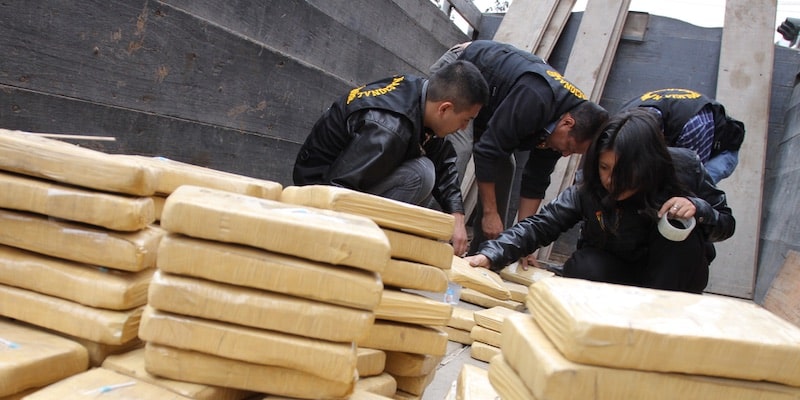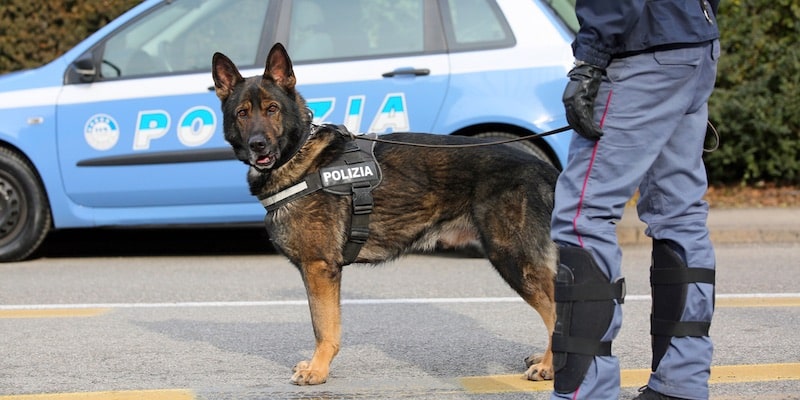We explain what drug trafficking is and why it is harmful to society. We also tell you its history and its situation in today's world.

What is drug trafficking?
Drug trafficking or drug trafficking is the clandestine production, distribution and marketing of drugs and illegal substances, causing addiction and harmful to health. It is an activity that takes place both nationally and internationally, despite the fact that it is prohibited and persecuted in most legal and criminal systems in the world, and which mobilizes a figure close to a trillion dollars a year.
Control of drug trafficking on a global scale falls to different clandestine groups, often known as “cartels.”. Most of them are militarized and are involved in other illegal activities. These organizations not only confront the State and the forces of law, but also compete with each other for control of the narcotics and narcotics market.
Each of these organizations is dedicated to the different phases of drug production and marketing, from the planting of the plants that serve as raw material, to its processing and subsequent manufacturing of the narcotic, its transportation to national and international markets, and their defense against rival producers and the law. Sometimes drug cartels become so powerful that they run themselves as if they were a parallel government controlling territory and establishing its own law.
Thus, drug trafficking It is a very difficult problem to eradicate despite the efforts of States and international organizations dedicated to combating drugs. Although drug production usually takes place in third world nations (especially Latin America, Afghanistan and Myanmar), The main consumer markets are in the developed world.
There are two main positions regarding the fight against drug trafficking: one that insists on waging all-out war on drug trafficking and keeping its actions illegal, and another that proposes legalizing some of its products in order to subject them to formal regulation and make them, thus, less lucrative.
Origin of drug trafficking
The marketing of narcotic substances is very old, but it did not always take place illegally and clandestine. In past times, many natural substances were used as anesthetics or socially consumed for social and diplomatic purposes, without the notion of drug trafficking yet existing. For example, cocaine was used as a stimulant in Europe well into the 20th century without knowing its harmful effects.
Instead, The first international military conflict linked to the presence and distribution of drugs was the First Opium War (1839-1842) which took place between Imperial China and the British Empire.
This conflict was due to the British Empire introducing smokable opium to China during its colonial period and gaining great influence thanks to the addiction that this substance aroused among Chinese citizens. Realizing this, the Chinese emperor ordered tons of opium to be dumped into the sea, which aroused the anger of the British and led them to militarily defend their ships loaded with opium, thus starting the war.
Curiously, opium came to America from the hands of the Chinese, through the port of Mazatlán, where the climate of Sinaloa turned out to be very favorable for the cultivation of the plant. It wouldn't be long before drug trafficking to the United States began.
Effects of drug trafficking on society

The effects of drug trafficking on society are always problematic. Especially because they are not limited to physical and mental harm to consumers but they also engender a network of corruption that contributes to social deterioration. These effects can be summarized as follows:
- Consumer addiction. The most direct and tangible effect of drug trafficking takes place on drug users, who suffer the psychological, social and physiological effects of their addiction to the substance. Thus, they can sacrifice central elements of their lives (job, savings, family, among others) in order to continue consuming, until they end up in illness, misery or madness.
- Increase in violence and corruption. The ill-gotten money from the sale of drugs allows the cartels to buy consciences and thus have access to weapons, personnel and all types of goods, which makes them a secret economic actor within society. To defend their business, unable to proceed in legal and civilized ways, these organizations continually engage in violent acts, such as murders or armed confrontations with other cartels.
- Money laundering. When drug trafficking cartels “cleanse” their money through the acquisition of goods, investment in projects, among other activities, they acquire large amounts of power within society, which they exercise in an invisible way to the State. Thus, they can manipulate the media and justice agencies, and even finance political campaigns.
Drug trafficking in the world
Globally, drug trafficking mobilizes billions of dollars annually as drug consumption spreads throughout the world, both in high-income countries and in third world countries. The countries where the raw materials are planted, harvested and processed, that is, The main drug producers and exporters are almost always countries in the Middle East and Latin America especially Colombia, Mexico, Honduras, Myanmar, Afghanistan and Laos.
There are different drug trafficking routes to the main global financial centers such as the United States, China, India and Europe. These routes may involve countries such as Pakistan, Iran, Türkiye, Greece and Bulgaria, mainly in heroin trafficking; and different nations of the Caribbean and Central America, in the case of cocaine. These two are the main and most dangerous drugs internationally. More than 80% of the world's cocaine consumption occurs between Europe and the United States alone and a similar figure in the case of heroin.
Drug trafficking in Mexico
The drug trafficking problem in Mexico reaches important dimensions. Initially it was linked to opium, brought by the Chinese to the coasts of Sinaloa and from there trafficked to the United States. In fact, between the 1930s and 1940s there were various opium dens in the country, to which marijuana and, later, cocaine were soon added.
However, Starting in the 1960s, the major drug cartels settled in the so-called “golden triangle.” where some farmers traditionally grew poppies and marijuana plants. The flow of undocumented immigrants to the United States and the very high demand for drugs in this country made this problem a joint issue between Mexico and the United States.
Consequently, many anti-drug operations were joint, while others were unilateral. For example, the US government of Richard Nixon carried out “Operation Interception”, which secretly harassed Mexico to prevent the transit of illegal immigrants and drugs into US territory.
The influence of drug trafficking in Mexico, however, did not decrease in the second half of the 20th century. Its influence penetrated politics and caused sadly famous episodes such as the shooting in the parking lot of the Guadalajara International Airport in 1993, in which the Catholic cardinal Juan Jesús Posadas Ocampo was murdered.
On that occasion, two large Mexican cartels faced each other: the Sinaloa cartel (commanded by “El Chapo Guzmán”) and the Tijuana cartel (commanded by the Arellano Félix). These cartels not only fight in Mexico, but they have a presence and alliances in other nations such as Colombia and Venezuela.
Other important episodes were the murder in 1994 of the PRI presidential candidate Luis Donaldo Colosio Murrieta in the city of Tijuana, and the murder in 1999 of the television host Paco Stanley in the middle of the street in Mexico City. These, however, are far from being isolated cases. Levels of violence related to Mexican drug trafficking have increased since 2000 despite the efforts of then-President Vicente Fox and the tightening of United States border measures after the September 11 attacks.
Most consumed drugs in the world
The main illicit drugs consumed in the world are:
- Cocaine. It is an alkaloid extracted from the leaf of the coca plant, a typical South American shrub, cultivated mainly in Peru, Bolivia and Colombia. Cocaine is a powerful and addictive stimulant that is usually ingested through the air (smoked or snorted).
- Heroin. It is an opioid with enormous addictive capacity, which is mostly ingested intravenously, as it is quickly converted into morphine in the bloodstream. Obtained by cooking poppy seeds, this highly destructive drug is mostly produced in Afghanistan, Laos and Myanmar.
- Dope. It is a psychotropic found in the flowers and resin of the plant. Cannabis sativacapable of acting as a powerful anxiolytic and relaxant, which is why it is also known for certain medicinal uses. It is normally ingested orally or respiratoryly (smoked), and despite having been banned in almost the entire world in the 20th century, today its recreational and personal consumption is beginning to be seen with different eyes.
- Methamphetamines. It is a psychostimulant known as deoxyephedrine, capable of quickly producing feelings of euphoria and well-being, relieving fatigue and generating rapid addiction. Although it has therapeutic uses, the majority of methamphetamine produced for illegal consumption comes from clandestine laboratories in the United States, China, the Czech Republic and the Slovak Republic.
Continue with: Crime
References
- “Drug trafficking in Mexico” on Wikipedia.
- “Drug trafficking” in Crimipedia.
- “Drug trafficking” in Deutsche Welle.
- “Drug trafficking” at the United Nations (UN).





